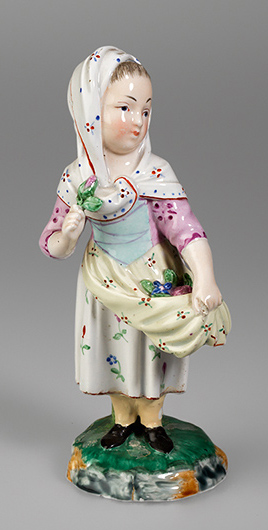
Also refers to the Höchst Porzellanmanufaktur (Höchst Porcelain Factory) (1746–1796), Dressel, Kister & Cie in Passau and successive businesses (1853–1942)
Roland Blaettler, Andreas Heege 2019
The Höchst Porzellanmanufaktur (Höchst Porcelain Factory) (Hessen) is well known for its large variety of figures produced by numerous different modellers throughout its 50-year period of production. They were often inspired by examples from Meissen, which they copied or produced variants of. However, some of the models were also original creations based on graphic designs (Stahl 1994, 185-314). The figures could be made in biscuit, decorated in a variety of colours or left unpainted.
When the porcelain factory in Höchst closed down in 1796, the factory and its entire inventory were sold at auction on 26th August 1798. In 1840, Daniel Ernst Müller acquired the old models for use in his own refined white earthenware factory, established in Aschaffenburg, Damm (Bavaria) in 1827. They were used as models to make new working moulds in plaster of Paris while case-moulds in fired clay were created to preserve the original models. Between 1840 and 1884, the factory produced copies of the popular Höchst figures in refined white earthenware, some with retouching, and occasionally in porcelain (Stenger 1949; Schad 1991; Zoike 1986; Stahl 1994, 297-302).
In 1886–1887, the moulds were acquired by Franz Anton Mehlem whose refined white earthenware factory in Poppelsdor near Bonn had been established in 1755. They were restored and used once again to make figures in refined white earthenware, though these were never actually sold (Stahl 1994, 302). In 1903, some 350 models were acquired by the porcelain factory Dressel, Kister & Cie in Passau (1853-1919), where they were again retouched and used to produce porcelain figures probably up until about 1919. Almost all copies, be they from Aschaffenburg, Damm or from Passau, were marked with a wheel symbol, the maker’s mark of the factory in Höchst, and sometimes combined with the letter “D” (HMO 8661) or with a bishop’s staff (Passau, Reber 1988, 192–200; Werhahn 2002).
In 1919 the company was sold and, until its liquidation in 1936, continued to trade under the name “Aelteste Volkstedter Porzellanfabrik AG, Zweigniederlassung Passau” (Volkstedt Oldest Porcelain Factory, Passau Branch). In 1928, a year before Höchst became part of the city of Frankfurt, the town authorities ordered a complete set of newly made copies of all existing Höchst models from the Volkstedter Porzellanfabrik AG. Comprising some 350 objects, the entire collection of “Old Höchst Reproductions” are still on display in the lavishly decorated rooms of the Bolongaro Palace in Frankfurt-Höchst and are in the care of the Historisches Museum Frankfurt (Frankfurt History Museum).
From 1937 to 1942, production continued under the name “Porzellanfabrik Passau” (Passau Porcelain Factory), but towards the end of the Second World War the company was destroyed and looted. We can probably assume that “Old Höchst Reproductions” using the existing moulds continued to be made by the Porzellanfabrik Passau until the outbreak of the war.
Some of the moulds ended up in the Oberhausmuseum in Passau and when it closed down, they were sold to a private individual, who in turn sold them on to the Porzellanmanufaktur Frankenthal (Frankenthal Porcelain Factory). Mystery surrounds their fate after the factory shut down in 1950 (Stahl 1994, 302).
Translation Sandy Haemmerle
References
Blaettler/Schnyder 2014
Roland Blaettler/Rudolf Schnyder, CERAMICA CH II: Solothurn (Nationales Inventar der Keramik in den öffentlichen Sammlungen der Schweiz, 1500-1950). Sulgen 2014, 382.
Reber 1988
Horst Reber, Höchster Porzellan aus drei Jahrhunderten. Ausstellung zu Aspekten der Kunst-, Wirtschafts- und Sozialgeschichte. Hohenberg an der Eger 1988.
Schad 1991
Brigitte Schad, Die figürlichen Erzeugnisse der Steingutfabrik Damm 1840-1884. Aschaffenburg 1991.
Stahl 1994
Patricia Stahl, Höchster Porzellan 1746-1796. Katalog zur Ausstellung Höchster Porzellan 1994, Frankfurt 1994.
Stenger 1949
Erich Stenger, Die Steingutfabrik Damm bei Aschaffenburg 1827-1884. Aschaffenburg 1949.
Werhahn 2002
Maria Christiane Werhahn, Die Porzellanfiguren der Passauer Manufaktur aus den Höchster Originalformen. Ein Beitrag zur Geschichte des Porzellans im 19. und 20. Jahrhundert. Neuss 2002.
Zoike 1986
Birgit Zoike, Die figürlichen Erzeugnisse der Steingutfabrik Damm nach Formen der kurmainzischen Porzellanmanufaktur in Höchst am Main (Höchster Geschichtshefte 44). Frankfurt 1986.

